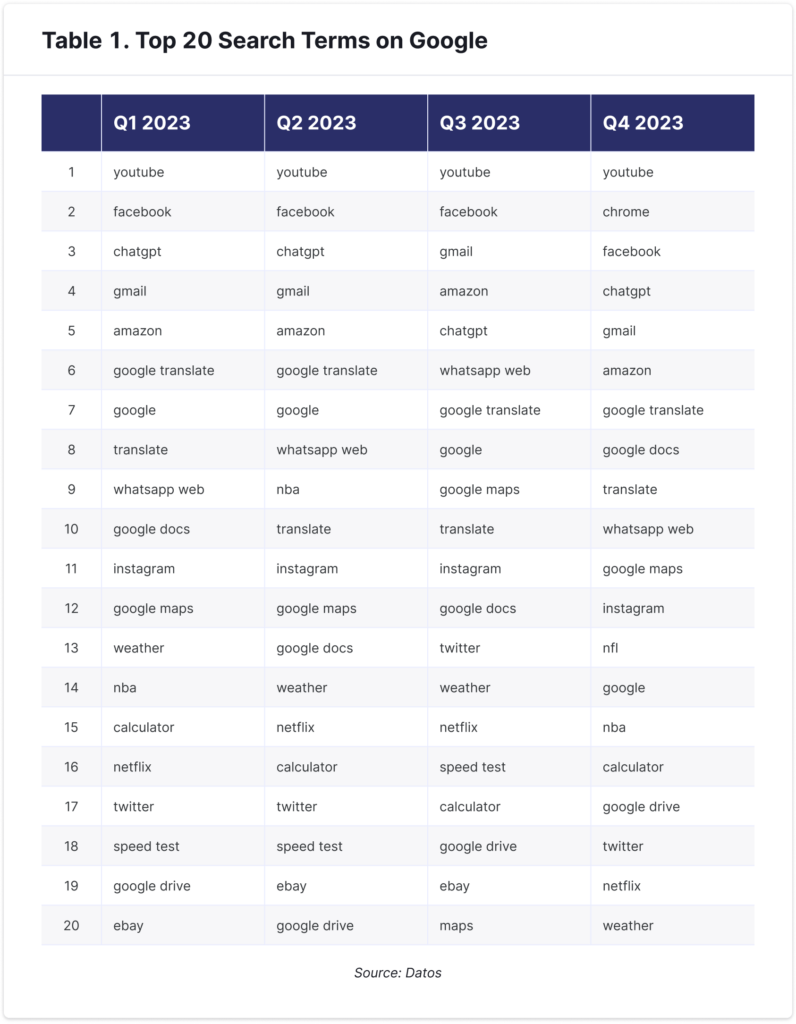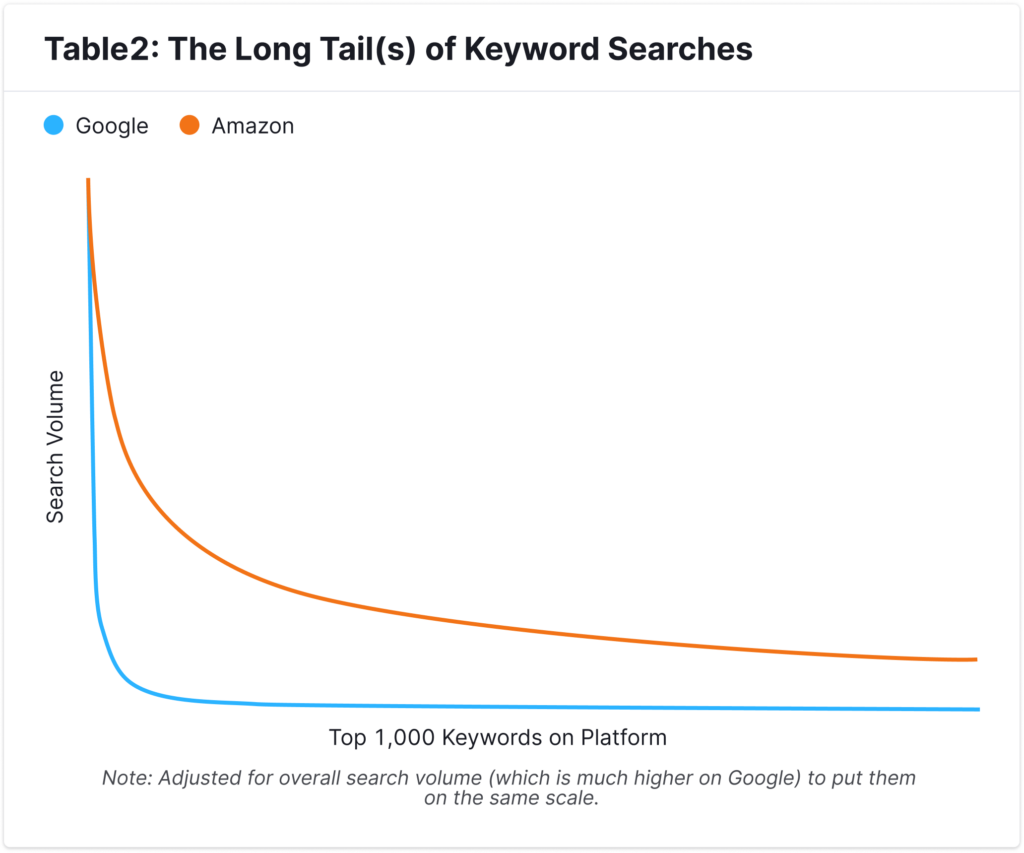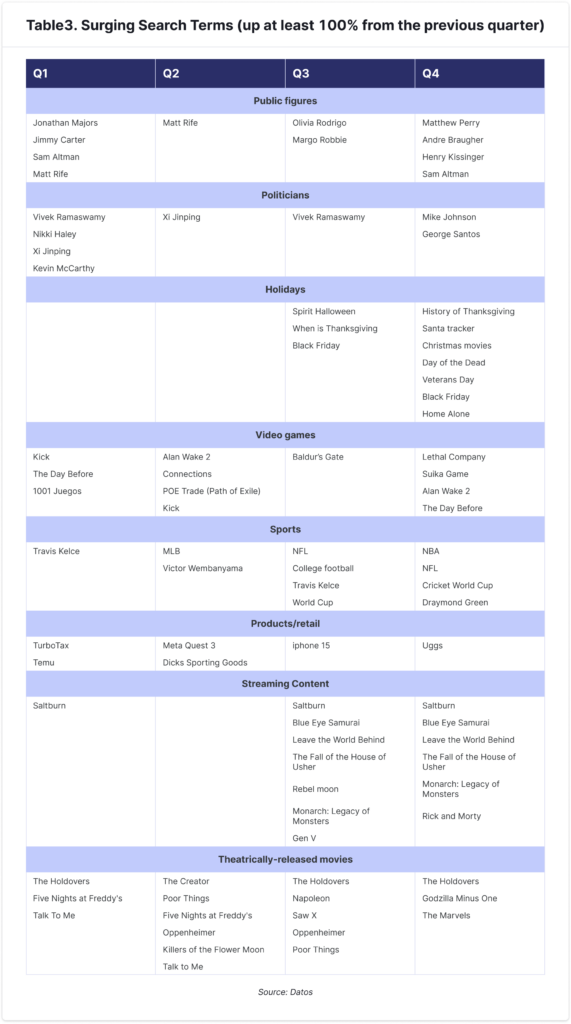Google remains the most widely used website, and search remains perhaps the most fundamental digital activity that people engage in. As we move further into 2024, I decided to take a closer look at how people used Google in the past year, with an eye toward how trends might evolve in the coming year.
For this effort I synthesized data from several sources – first among these was data from Datos, a global clickstream data provider focused on licensing anonymized, at scale, privacy compliant datasets. From Datos, I examined the top 1,000 Google search terms in the United States for each quarter in 2023. The data included Internet searches on desktops, laptops, and mobile devices, but did not include searches conducted through the Google app.
Searching Is Google’s Business, and Business Is Good
After a shaky start to the year, Google reported a total of $305 billion in revenue in 2023, up 11% from the year before and their highest ever. Most of that comes from search revenue. While advertisers continue spending more to reach consumers during the search process, consumers continue to search more, with the total volume of searches consistently on the rise.
Google as Desktop
As I have written before, the top search terms on Google illustrate how it has become a desktop for our digital lives. A jumping off point to the most important destinations. The most common searches aren’t quests for information – they are a substitute for a collection of bookmarks.
Of course, in many cases, those jumping off points are Google-owned: YouTube. Gmail. Maps. Translate. Docs. Drive. People even google the word “Google.”
As shown in Table 1, the top twenty terms (and particularly the top 5) are generally stable, but there are newcomers on the list. In Q4 2023, Chrome jumped to #2 on the list. Google unveiled a significant upgrade to Chrome in November 2023, which included a new visual design, prompting searches about the new look as well as how to revert to the old look. Many also searched Chrome for information about Google’s widely-discussed plan to phase out third-party cookies in 2024. In previous quarters, searches related to Chrome generally ranked outside of the top 200 terms.
While Chrome may be a “one hit wonder” in the top 10, it is joined by a new mainstay in the top 10: chatgpt. From essentially no searches for the term in Q3 2022, it burst on the scene in Q4 2022, and consistently ranked in the top 5 throughout 2023. As we will see, the rising tide of interest in AI has also buoyed searches for related companies and tools, although none have reached the Top 20.
Facebook consistently ranked #2, until being supplanted by Chrome in Q4, and is periodically joined in the top 20 by Facebook owned Instagram and Whatsapp. Amazon consistently ranks in the 4-6 range, and continues growing, with their Q4 search activity ending 4% higher than a year ago.

Beyond the Top 20: A Broader Desktop
Beyond the top 20 are also keywords that serve as shortcuts to popular branded sites. Ranking between #20 and #50 are brand names in categories such as…
- social media (Twitter, TikTok, LinkedIn, Discord, Twitch, Pinterest)
- streaming media (Netflix, Spotify, Prime Video)
- games (Wordle, Roblox)
- retail (Walmart, eBay, Home Depot). Just outside the top 50 were additional retail sites such as Best Buy, Target and Etsy.
Searches for streaming media sites are generally on the rise, while searches for social media brands and casual gaming sites are largely stable. Not surprisingly, searches for retailers typically display seasonality, peaking in the Q4 holiday shopping season. But two retailers stand out in terms of growth – Walmart, whose Q4 2023 peak was up 10% from the prior year, and eBay, which shows less dramatic Q4 seasonality, but also shows consistent growth over the past few years. The strength of both Walmart and eBay reinforce the view of today’s consumer as frugal and value-oriented. Further reinforcing this view are Shein and Temu, value-oriented brands that have seen tremendous recent growth and finished 2023 in the Top 100 search terms. Looking further down the list to more upscale retailers, Macy’s (#159) Q4 spike was 21% less than a year ago.
Beyond the “Desktop” Function: The Long-Tail of Searches for Content
As we move beyond the most common terms – those serving the “desktop” function of directing users to their most common destinations – we find that the number of searches per keyword falls off quickly. This is the classic “long-tailed” distribution characteristic of many aspects of digital behavior. If we looked at the top websites and ranked them by traffic, for example, we would see the same pattern. Even in offline markets, such as consumer packaged goods in retail stores, we see a few well-known brand names dominate the market, with a larger number of niche brands fighting over the remaining dollars in the market.
The distribution of keyword searches on Google is one of the most long-tailed in the digital world. It is, for example, more extreme than the distribution of keyword searches on Amazon (Table 2). And the Google distribution continues to get more “long-tailed” over time. The statistical measure of “long-tailedness” is called kurtosis. Throughout 2022, the kurtosis associated with the top 1,000 keywords on Google hovered around 80. By 2023, the figure was closer to 230 – a nearly three-fold increase.

So what lies beyond the “fat head” of distribution? What are the most frequently searched for “content” terms?
Admittedly, the methodology of looking at the top 1,000 search terms skews results toward high-traffic sites with well-known brand names. It is a blunt-force approach that will miss the subtleties of the more nuanced questions we ask Google. It has been reported that 8% of Google searches are in the form of questions, and 15% of Google searches are unique – that is, no one has made those searches before.
Still, digging deeper into the top terms is instructive, and a few terms in the top 20 offer clues – specifically, the NBA and NFL rank just outside the top 10. This reflects both widespread interest in football and basketball, but also implies that there is no media brand synonymous with the sports. If, for example, ESPN.com was the definitive go-to website for fans of those sports, then ESPN would likely rank higher than its current #81 position.
“Surging” Search Terms
The interest in sports also highlights the importance of exploring seasonality and “keyword surges” in the data (Table 3). Each year, football season kicks off (pun definitely intended) in September, and with it come a surge of football-related searches, including not just “NFL,” but also “NFL games today,” “NFL scores,” “Monday Night Football,” and many popular teams names (e.g., Cowboys, Jets, etc.). Similar surges in traffic to a range of sports-related keywords occur as seasons get started – Q2 for baseball and Q4 for basketball – after that interest stabilizes and increases modestly as the playoffs arrive.
Looking at “surging” search terms across the year further reveals the ebbs and flows of our interests. Movie releases and hot streaming shows make regular appearances on the list, particularly as the “prestige” TV season emerges in the second half of the year. Saltburn appears three times – a slow burn as it built on its own buzz and momentum. Interestingly, Oppenheimer made the list, but Cillian Murphy did not; Margo Robbie made the list, but Barbie did not.
Many sports terms make the list, but only three athletes: suspension-prone Draymond Green, rookie sensation Victor Wembanyama, and Taylor Swift paramour Travis Kelce, who surged twice. Searches for Taylor Swift didn’t surge because they were consistently high, and she ended the year as the #131 search term. Keep in mind that this analysis looks at keywords that surged from quarter to quarter, so shorter-term bursts may not be detected.
Relatively conspicuous by their absence are top news stories. Politicians occasionally make this list, particularly if they are new to the public stage or take a public stumble. And terms related to the Israeli/Palestinian conflict did surge in Q4. But for the most part, people don’t view Google as their news hub – instead people go to their preferred sites for news coverage. News-seeking behavior is typically siloed in this way.

Summing Up: A Look Ahead
Certainly Google searches aren’t perfect indicators of future economic activity. But it is telling that Amazon, Walmart, eBay, Shein and Temu are all getting more search activity, while Macy’s is getting less. My analysis of holiday shopping pointed to a similar conclusion – enthusiasm for shopping and consumption today are modest at best. Even though the stock market is at all-time highs, inflation has fallen, and unemployment is near historic lows, the consumer mindset is one of caution and value-orientation. It’s been called the “vibe-session” – an emotional recession despite strong macro-economic indicators.
While our enthusiasm for stuff is modest, we are increasingly seeking experiences and connections. Our enthusiasm for entertainment – from movies to streaming content to new video games – remains strong. “Surging” search terms not only indicate more individual activity on a computer or phone – it likely also indicates “water cooler” conversations about what’s hot and what’s not. While we struggle to regain our economic optimism in the post-pandemic era, we are reprioritizing our efforts toward social connections and emotional comfort.




